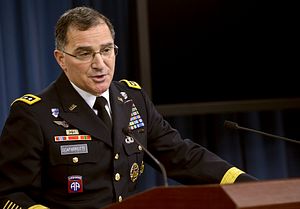North Korea has the ability to miniaturize nuclear warheads, the top U.S. military commander in Korea said on Friday.
On Friday General Curtis Scaparrotti, the commander of U.S. Forces Korea, briefed reporters at the Pentagon in Washington, DC. During the press conference, Scaparrotti was asked if North Korea had the capability to marry a miniaturized nuclear warhead to a ballistic missile.
“Personally I think that they certainly have had the expertise in the past,” Scaparrotti said. He added, “They’ve had the right connections, and so I believe have the capability to have miniaturized a device at this point, and they have the technology to potentially actually deliver what they say they have.”
He later clarified that he doesn’t believe North Korea has actually placed a nuclear warhead on a missile yet, and stressed that his assessment of Pyongyang’s capabilities was based on his personal opinion rather than on hard evidence.
“I don’t know that they do. What I’m saying is, is that I think given their technological capabilities, the time that they been working on this, that they probably have the capabilities to put this together. I don’t believe that they have. I don’t know that they have at this point.”
Scaparrotti noted that North Korea has “proliferation relationships” with Pakistan and Iran, either of whom might have helped it in developing the capability to miniaturize nuclear warheads so they can fit on ballistic missiles.
North Korea has conducted three nuclear tests since 2006 but it has yet to demonstrate the capability to miniaturize a nuclear warhead. In recent years, the question of whether North Korea this capability has been hotly debated in the United States and the Asia-Pacific.
North Korea itself claimed that its February 2013 nuclear test was of a “miniaturized and lighter nuclear device.” In April of last year, the U.S. Defense Intelligence Agency– the Pentagon’s intelligence shop– assessed with “moderate confidence” that North Korea has acquired this capability. Other U.S. intelligence agencies, as well as South Korean ones would not corroborate this at the time, and President Barack Obama himself also directly refuted the assessment.
At the time, most nuclear experts outside of government also cast doubt on the DIA assessment. For example, a July 2013 analysis by the Center for Arms Control and Non-Proliferation, a Washington, DC think tank, wrote that: “It is generally believed to have not yet developed the capabilities needed to miniaturize a nuclear device for missile delivery.”
During his confirmation hearings in October 2013, Choi Yun-hee, the chairman of South Korea’s Joint Chiefs of Staff did say, “Considering the nuclear development so far, I believe [North Korea] has made considerable progress in warhead miniaturization.” Similarly, earlier this year an unnamed South Korean official told Reuters: “It is likely there has been progress, but on the question of whether they have actually achieved it, I’d have to say not yet.”
Even when North Korea succeeds in miniaturizing a nuclear warhead, it would still not necessarily have a reliable nuclear deterrent. As Gaurav Kampani, a Post-Doctoral Fellow at the Norwegian Institute of Defence Studies, explained in a recent issue of International Security:
“It is important to draw distinctions between the development of a nuclear device, a weapon, the process of weaponization, and operationalization…. A device is an apparatus that presents proof of scientific principle that a nuclear explosion will occur. The weapon is a rugged and miniaturized version of the device…. Weaponization is the process of integrating the weapon with delivery systems. Operationalization entails the development of soft institutional and organizational routines. It refers to command and control mechanisms, coordination procedures between scientific and military agencies, and training protocols in the military to deploy and explode weapons.”
Currently, North Korea is working or may have achieved the second part of this sequence. Among the challenges it will still face after miniaturized, is making sure the warhead is able to survive re-entry into the atmosphere, where it may encounter pressure 20 times the force of gravity and temperatures as high as 2,000 °C.
































